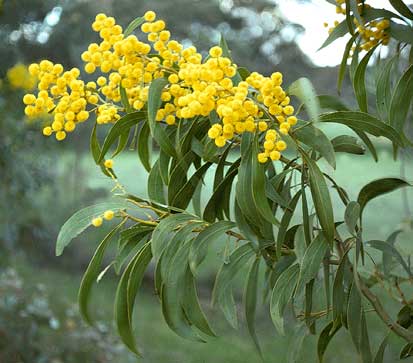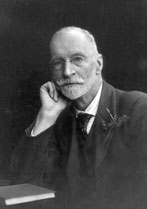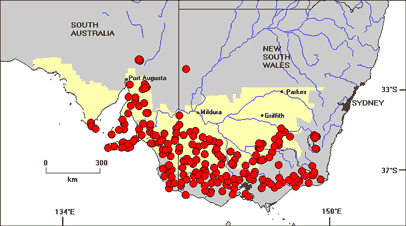On 1 September 1988 Golden Wattle (Acacia pycnantha) was officially proclaimed as Australia’s National Floral Emblem.

Historical perspective
Acacia pycnantha had long been popularly regarded as Australia’s national flower but this was not made official until 1988, largely as a result of urgings by Maria Hitchcock and her associates (see Hitchcock 1991). Historically the declaration of a national flower was linked to the issue of recognizing an official Wattle Day. Acacia pycnantha was the last of Australia’s floral emblems to be proclaimed (each State has its own floral emblem), and this occurred after a long and sometimes difficult journey.

Archibald James Campbell (Photo courtesy of Ian Campbell)
An early advocate for Wattle as the Australian national flower was Archibald James Campbell. On 8 September 1908 Campbell delivered a lecture to the Melbourne Photographers’ Club titled ‘Wattle Time; or Yellow-haired September’ in which he stated that ‘by numbers, the Wattle is almost exclusively Australian, and should undoubtedly be our National Flower’ (see Boden 1985). A published version of this lecture appeared in Campbell’s 1921 book ‘Golden Wattle: our national floral emblem’ where on page 16 he shows a photograph of A. pycnantha labelled ‘Australia’s National Flower’. However, the call for A. pycnantha as the national flower was not unanimous because there had been debate about whether Wattle or Waratah (Telopea speciosissima) should assume this honour. It was R.T. Baker who advocated the choice of the Warratah (which is now the floral emblem of New South Wales) (see Sowden 1913, Boden 1985 and Hitchcock 1991 for further details). Joseph Henry Maiden (the Director of the Sydney Botanical Gardens) was a keen advocate of Wattle as becoming the national flower, however, he did not suggest any particular species (see Maiden 1910). As discussed by Boden (1985) the adoption of Wattle as the national flower tends to be confirmed by its incorporation into the design of the Australian Coat of Arms; this was depicted in the Commonwealth Government Gazette on 18 January 1913. However, as discussed elsewhere the Wattle depicted is not a botanically accurate representation of A. pycnantha and is unlikely to be that species.
Another early call for A. pycnantha to be the national flower occurred on 7 October 1912 when the Adelaide branch of the Wattle Day League (under the Chairmanship of Will Sowden) formally adopted as one of its aims ‘to establish golden wattle (Acacia pycnantha) as the national flower and emblem of Australia’. Sowden (1913) considered that there was no particular reason why any other appropriate Wattle should not have been nominated. The decision as to exactly what Wattle species should constitute the emblem was to be decided at a national Conference of the Wattle Day League that was held in Melbourne on 8 January 1913. The Conference, however, did not nominate a species. Previous to this there had been a suggestion by a Mr David Scott, based on an article that appeared in The Melbourne Herald newspaper on 14 February 1891, that Australia should adopt Wattle as its national emblem and three species were suggested, namely, Silver Wattle (A. dealbata), Black Wattle (A. mearnsii) and Golden Wattle (A. pycnantha). Details of Scott’s suggestions are provided by Sowden (1913). Of these three species Scott considered A. pycnantha to be “of the highest value” (because it was then very important in the Australian tanning industry, see Searle (1991) for a discussion of this industry). As already noted above, by 1921 A. pycnantha was being referred to as Australia’s national flower.
In the 1980’s when Maria Hitchcock and her associates were urging the government to formally recognize Wattle as Australia’s national floral emblem, the obvious choice of species was A. pycnantha. In November 1987 a submission to this effect was made to the then Prime Minister of Australia, Right Hon. R.J. (Bob) Hawke.
Golden Wattle (Acacia pycnantha) was officially proclaimed as Australia’s National Floral Emblem. in 1988, Australia’s bicentennial year. The Gazettal, which is dated 1 September 1988, was signed by the Governor General, Sir Ninian Stephen on 19 August 1988. The proclamation ceremony was conducted on the first day of spring (1 September) in the Australian National Botanic Gardens, Canberra, where the then Minister for Home Affairs, the Hon. Robert Ray, made the formal announcement.
Although is it is understandable why A. pycnantha was ultimately selected as Australia’s national flower, it is in some respects an unusual choice. The species is certainly attractive with its showy, large, bright golden flowerheads, is suited to being depicted pictorially in insignia, and was well-known to early advocates within the Wattle Day movement (especially on account of its considerable commercial significance at that time). However, Golden Wattle has a somewhat restricted natural distribution in Australia, being confined to parts of South Australia, Victoria and New South Wales; furthermore, it is already an environmental weed in some places, both within Australia and abroad (see Maslin & McDonald in press). While not objecting to the choice of A. pycnantha it is noted that there are other species (such as A. aneura, Mulga, or A. ligulata, Dune Wattle) which are more widely distributed within the continent and as such might be regarded as having greater unifying symbolism (but perhaps not all the other characteristics of the selected national flower).

Natural distribution of A. pycnantha
Original collection and description of A. pycnantha
Acacia pycnantha was first collected on 5 July 1836 by Major Thomas Mitchell, Surveyor-General of the colony of New South Wales, from between the Loddon River and Pyramid Hill near Bendigo, Victoria. Mitchell’s specimen is now housed in the Herbarium at Cambridge University (see Maslin 2001). It is labelled ‘Interior of New Holland. A. falciformis. A.C. Major Mitchell’s Expedition, 1836, 5 July (222)’, but a tag attached to this sheet reads ‘A. pycnantha’.
The species was formally described in 1842 by the famous British botanist, George Bentham.
Derivation of botanical name
pycnantha: this botanical name is derived from the Greek pycnos (meaning close, thick, crowded) and anthos (flower). It alludes to the compact flower heads that characteristically contain many densely-arranged flowers.
Derivation of common name
Golden Wattle: on account of its distinctive bright golden blossoms, Other common names that have in the past been applied to this species include Broad-leaved Wattle (South Australia), Green Wattle (now the Standard Trade Name for A. decurrens), Black Wattle (now the Standard Trade Name for A. mearnsii) and Witch (Aborigines of Lake Hindmarsh Station, Victoria) (see Maiden 1907).
Botanical descriptions of A. pycnantha
There are numerous published descriptions and illustrations of Golden Wattle available, for example, Maiden (1907), Costermans (1981), Cunningham et al. (1981), Tame (1992), Whibley & Symon (1992), Maslin et al. (1998), Maslin (2001 & 2001a), Kodela (2002) and Maslin & McDonald (in press).
Descriptions are also available on the web, provided by the Australian National Botanic Gardens, the National Herbarium of New South Wales and by Rod Panter from the Department of the Parliamentary Library.
Useful links
An informative article on the Australian Floral Emblem provided by the Australian National Botanic Garden (Murray Fagg and Anne Boden).
References
Bentham, G. (1842). Notes on Mimoseae, with a Synopsis of Species. London Journal of Botany 1: 318-528. [Acacia pycnantha is described on page 351.]
Boden, A. (1985). Floral emblems of Australia. (Australian Government Publishing Service: Canberra.)
Campbell, A.J. (1921). Golden Wattle. Our national floral emblem. (Osbboldstone & Co: Melbourne.)
Costermans, L. (1981). Native Trees and Shrubs of South-eastern Australia. (Published by Rigby Publishers Ltd.)
Cunningham, G. H., Mulham, W.E., Milthorpe, P.L. and Leigh, J.H. (1981). Plants of western New South Wales. (Government Printer, Sydney.)
Hitchcock, M. (1991). WATTLE. (Australian Government Publishing Service: Canberra.)
Kodela, P.G. (2002). Acacia. In Flora of New South Wales. Revised edition, Volume 2. (Ed. G.J. Harden), pp. 381–476. (University of New South Wales: Sydney.)
Maiden, J.H. (1907). Acacia pycnantha, Benth. The Broad-leaved Wattle. The Forest Flora of New South Wales 3(8): 137-143, pl. 107 & photographs (Govt. Printer: Sydney.)
Maiden, J.H. (1910). The Botany of the Wattle. The Lone Hand, pp. 362-364.
Maslin, B.R. (2001). Acacia pycnantha. Flora of Australia 11A: 297.
Maslin, B.R. (coordinator) (2001a). WATTLE Acacias of Australia. CD ROM Publication. (Published by Australian Biological Resources Study, Canberra and Department of Conservation and Land Management, Perth.)
Maslin, B.R and McDonald, M.W. (in press). AcaciaSearch: Evaluation of Acacia as a woody crop option for southern Australia. To be published by Rural Industries Research and Development Corporation, Canberra.
Maslin, B.R., Thomson, L.A.J., McDonald, M.W. and Hamilton-Brown, S. (1998). Edible wattle seeds of southern Australia. A review of species for use in semi-arid regions. (CSIRO: Australia.)
Page, R. and Johnston, C. (1997). Wattle. Gould Leaguer 5(6): 1-28 (The Gould League of NSW Inc.: Gladesville, N.S.W.)
Searle, S.D. (1991). The rise and demise of the black wattle bark industry in Australia. Technical paper no. 1. (CSIRO Division of Forestry: Canberra.)
Sowden, W.J. (1913). Outline History of the Wattle blossom celebration in Australia. History of the Wattle Day movement. (Published for the Australian Wattle Day League and printed by W.K. Thomas and Co., Adelaide.)
Tame, T. (1992). Acacias of southeast Australia. (Kangaroo Press: Kenthurst, Sydney.)
Whibley, D.J.E. and Symon, D.E. (1992). Acacias of South Australia. (South Australian Government Printer: Adelaide.)